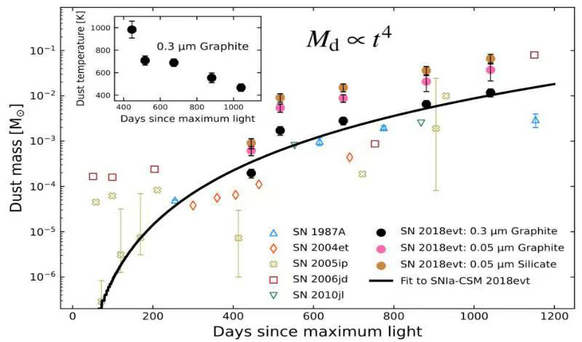Cosmic Dust Storms of a Type Ia supernova
Cosmic dust is similar to dust on Earth - groupings of molecules that have condensed and stuck together in a grain. An international team of astronomers has discovered a previously unknown source of dust in the universe - a Type Ia supernova interacting with gas from its surroundings. The results are significant because the exact nature of dust creation in the universe has long been a mystery.
The study was published in Nature Astronomy on February 9, 2024, Which was led by Dr. WANG Lingzhi, an associate research professor at the Chinese Academy of Sciences South America Center for Astronomy (CASSACA), together with other astronomers from China, the United States, Chile, United Kingdom, Spain, etc.
Supernovae have been known to play a role in dust formation, and to date, dust formation has only been seen in core-collapse supernovae, which are the explosions of massive stars. Since core-collapse supernovae do not occur in elliptical galaxies, the nature of dust creation there has remained elusive. These galaxies aren't organized into a spiral pattern like our Milky Way galaxy but are giant swarms of stars. The new study finds that thermonuclear Type Ia supernovae, the explosion of a white dwarf star in a binary system with another star, may account for a significant amount of dust in these galaxies.
The researchers monitored a supernova, SN 2018evt, for over three years using space-based facilities like NASA's Spitzer Space Telescope and NEOWISE missions, and ground-based facilities like the Las Cumbres Observatory's global network of telescopes, and other facilities in China, South America, and Australia. They found that the supernova was running into material previously cast off by one or both stars in the binary system before the white dwarf star exploded. The supernova sent a shock wave into this pre-existing gas. As the researchers monitored the supernova over more than 1,000 days, they noticed that its light began to dim precipitously in the optical wavelengths that our eyes can see, and then started glowing brighter in infrared light. This is a telltale sign that dust was being created in the circumstellar gas after it cooled following the supernova shock wave passing through it.
"The origins of cosmic dust have long been a mystery. This research marks the first detection of a significant and rapid dust formation process in the thermonuclear supernova interacting with circumstellar gas," said WANG Lingzhi, first author of this study.

Fig.1: Schematic sketches of SN 2018evt at the different phases a, b, and c. The artwork at the top right presents the dust formation process produced by ChatGPT.
The study estimated that a large amount of dust must have been created by this one supernova event, more than 1% of the sun's mass. As the supernova cools, the amount of dust created should increase, perhaps tenfold. While these dust factories aren't as numerous or efficient as core-collapse supernovae, there may be enough of these thermonuclear supernovae interacting with their surroundings to be a significant or even dominant source of dust in elliptical galaxies.
"This work offers insights into the contribution of thermonuclear supernovae to cosmic dust, and more such events may be expected to be found in the era of the James Webb Space Telescope (JWST)," said Prof. WANG Lifan of Texas A&M University, a co-first author of this study. The Webb telescope sees infrared light that is perfect for the detection of dust.
"The creation of dust is just gas getting cold enough to condense," says Prof. Andy Howell of Las Cumbres Observatory and the University of California Santa Barbara. Howell is the Principal Investigator of the Global Supernova Project, whose data was used in the study. "One day that dust will condense into planetesimals and, ultimately, planets. This is creation starting anew in the wake of stellar death. It is exciting to understand another link in the circle of life and death in the universe."
This paper can be accessed at https://doi.org/10.1038/s41550-024-02197-9.

Fig.2: Temporal evolution of the mass of the newly-formed dust in SNIa-CSM 2018evt with different compositions, together with the dust masses estimated for core-collapse supernovae. The black line presents the power law fit to the mass of the newly formed dust of SN 2018evt for 0.3 um graphite grains.(Credit: NAOC)
Media Contact:
Prof. XU Ang
Email: annxu@nao.cas.cn
Web: http://english.nao.cas.cn